Displaying items by tag: destinations
Christmas traditions in Greece
In Greece, the Christmas period lasts 14 days, officially beginning on Christmas Eve and ending on 6 January with Epiphany
Greece is a country that has a lot to tell and that can satisfy even the most demanding travellers, not only for its historical vestiges and its paradisiacal beaches, but also for its strong ties to traditions that emerge especially during religious festivities.
At a time of uncertainty, we would like to tell you about the traditions that the Greek people have always maintained with patriotism and attachment, traditions that have been handed down from generation to generation and that not even the desire for progress and novelty can ever erase. In Greece, the majority of the population faithfully follows the Orthodox Christian religion, so many of the traditions are linked to recurring religious celebrations. However, many traditions occur spontaneously, regardless of religious belief.
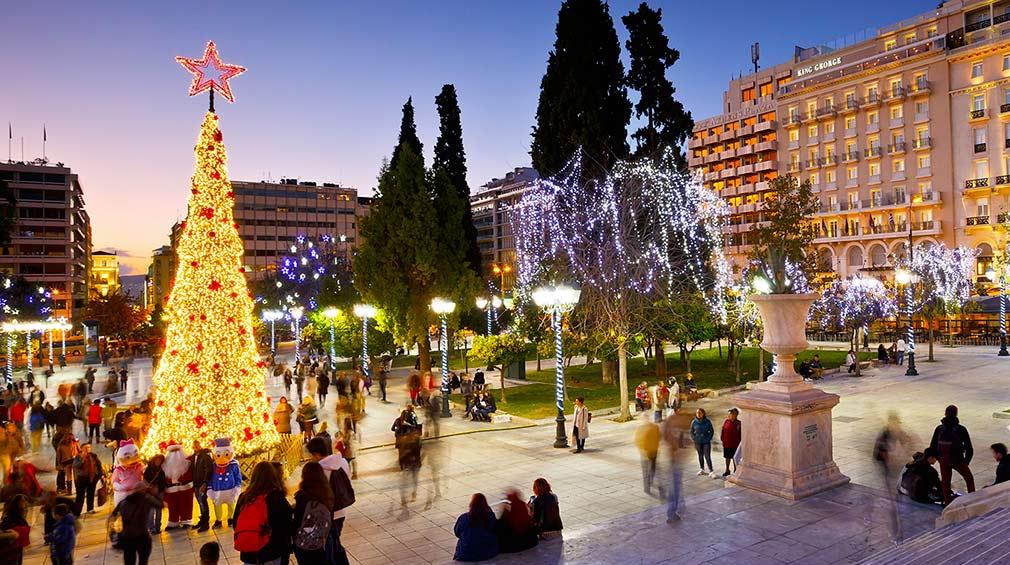
The exchange of gifts
Christmas celebrations in Greece begin with the celebration of St Nicholas on 6 December. This is one of the days when children receive presents, but unlike in other parts of the world, it is not only St Nicholas who brings gifts. St Nicholas is joined by St Basil (Agios Vassilios in Greek) on 1 January, when it is customary to exchange gifts with friends and family. The 24th and 25th of December are fully religious days to spend with the family, but without gifts!

Christmas decorations
The Christmas tree is not exactly a Greek Christmas symbol, although year after year it is entering more and more people's homes. In fact, the Greek tradition is for houses to be decorated with beautiful illuminated wooden models of various sizes that faithfully reproduce sailing boats. It is easy to understand why: in Greece there is no strong attachment to the land as in the Nordic countries, but on the contrary, there is a strong propensity to worship and thank the sea for all that it can offer the population: food, work, transport, tourism and much more. Strolling through a Greek town at Christmas time gives visitors a warm atmosphere where an incredible mix of traditional and contemporary ornaments intertwine. Every house, every shop, every square, every street conveys wonderful emotions.
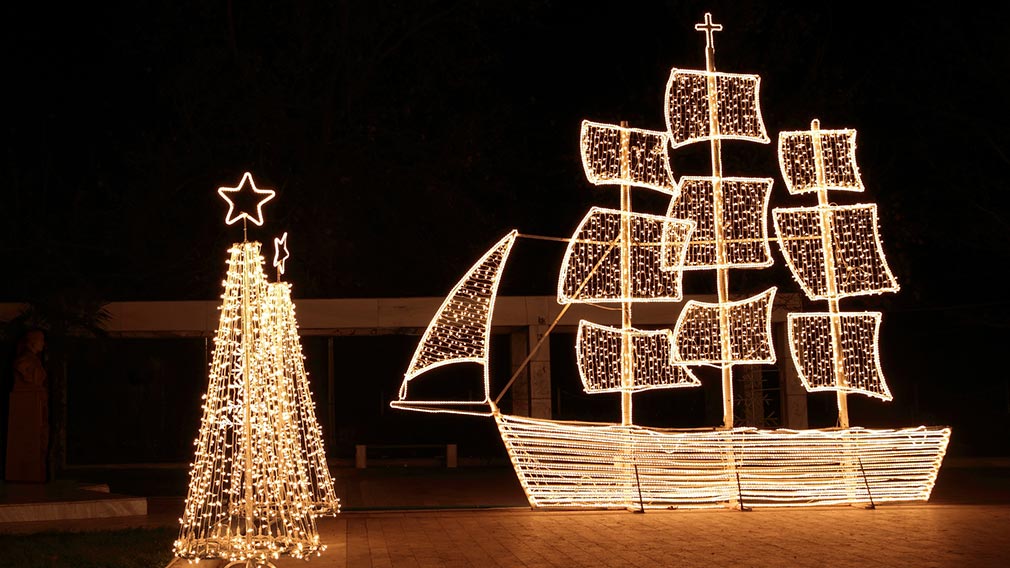
Peculiar objects
It is common practice in homes to display one of the oldest symbols of Greek Christmas: a small, shallow wooden bowl filled with water and wrapped with a string hanging from the rim, to the end of which are tied a sprig of basil and a crucifix. The thread keeps the basil fresh and moisturised, which in turn keeps away the 'Kallikantzaroi', the evil spirits.
According to tradition, these negative entities are also kept away on New Year's Eve, when it is common to burn fresh twigs, leaves and even old shoes. This would ensure good luck and prosperity for the new year!

Greek Christmas dishes and sweets
Christmas, as in Italy, is about family, cheerful children, the desire to be together with one's loved ones... and if in our country we find laid tables, cappelletti in broth, roasts, nougat, pandoro and panettone, in Greece there is no lack of all these delicacies... in short, the country changes, but the great amount of food consumed in the family does!!!
The main Christmas meal is often based on meat, roasted or spit-roasted of course, lamb and pork are never missing, together with the "tiropita" in all its versions, a typical savoury pie, filled with spinach, cheese or cold cuts, all accompanied by fresh and colourful salads and other vegetables.
Not to be missed is the typical sweet and super-decorated bread, the 'Christopsomo', the bread of Christ, decorated with a cross on top, round, fragrant and flavoured with cinnamon, orange and cloves, prepared according to tradition by Greek ladies on Christmas Eve, so that it remains fragrant the following day! Another popular dessert that cannot be missed are the 'Melamakaromo' biscuits decorated with chopped nuts and kneaded simply with flour, olive oil and honey.
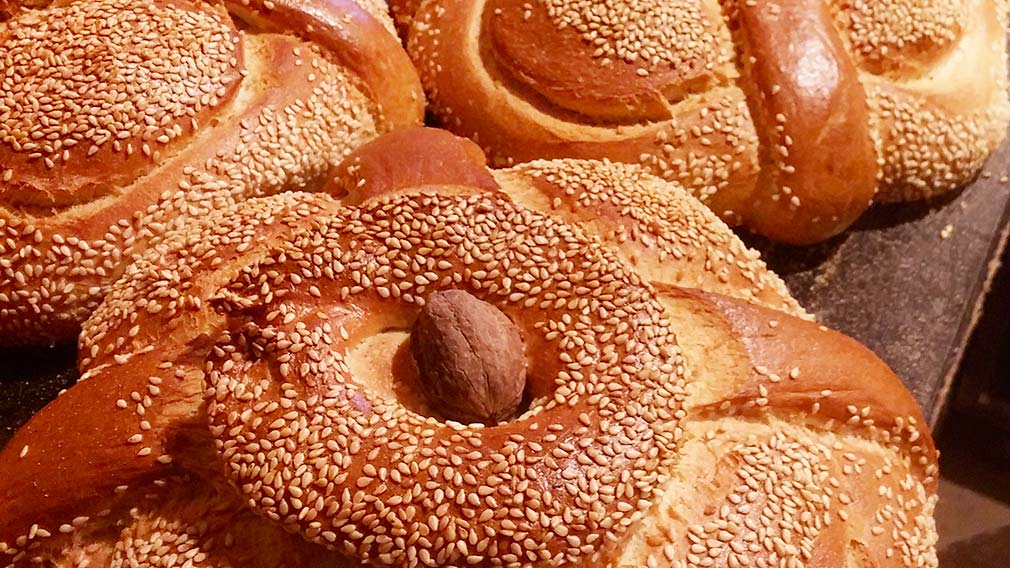
The New Year day
The New Year's Eve celebrations are also very popular in Greece, celebrated in much the same way as in Italy, with some differences in the food consumed. While the quintessential gastronomic symbol of Italy's New Year's Eve is lentils and cotechino, the bearers of prosperity and good fortune for the new year, in Greece the gastronomic New Year is linked to the 'Vassilopita', the traditional sweet cake dedicated to St Basil. The special thing about this famous cake is that a coin is hidden inside the dough. The tradition of the Vassilopita is that the head of the family cuts the first slices, which are never distributed to the family, because they are consecrated to Jesus, the Virgin Mary and St Basil to protect the house and the family, then the slices are removed and the remaining slices are given to each diner, and the person who finds the coin in their slice will have a very lucky New Year!

Epiphany and the blessing of water
Epiphany... all feasts are taken away, but it is no less important than any other feast day. On the contrary, for the Orthodox, 6 January commemorates the baptism of Jesus in the waters of the Jordan by St John the Baptist and is therefore a commemoration of what is known as the 'blessing of the water'. During this celebration, priests throw a crucifix into the sea, rivers and lakes and a group of men jump into the water to retrieve it. According to tradition, whoever finds the cross will be blessed for the whole year and the water will be purified.
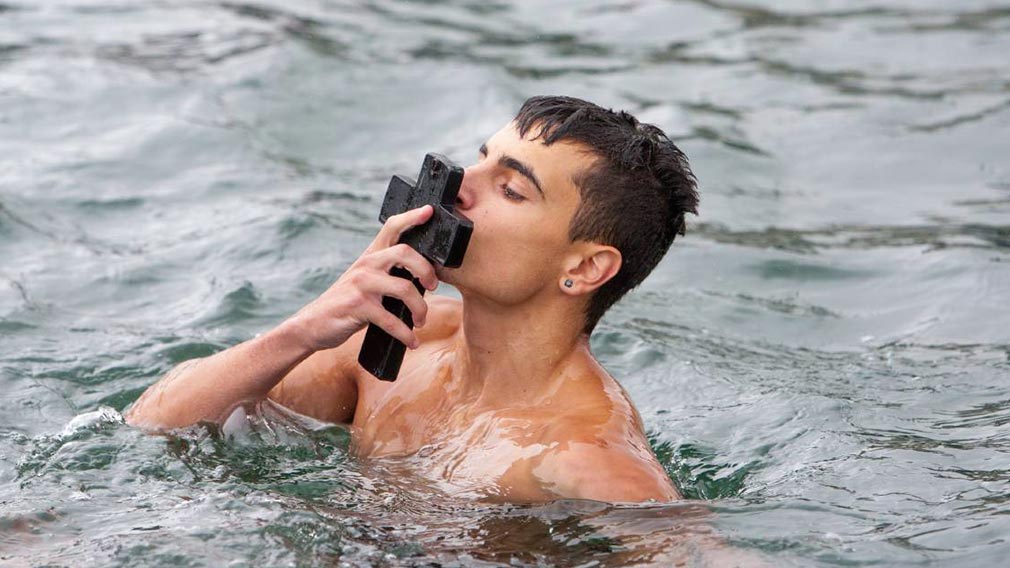
In conclusion, we can say that religion, spirituality, tradition, family and good food are the secrets of Greek festivities. All that remains is to wish you a happy holiday:
"Kαλά Χριστούγεννα" (read kalá Christoúgenna): Merry Christmas!
"Xρόνια πολλά' (Xronia Polla): Happy New Year!
Corfu: 25 must-see attractions
Not only beaches and fun, but also historical and cultural places with great charm
A holiday in Corfu in Greece offers something to all types of tourists: sea, nature, fun and culture. In this article we guide you to discover the monuments, historical places and museums not to be missed
Corfu is certainly the most famous Greek island of the Ionian archipelago and one of the most important tourist islands in the whole Hellenic territory. Every year millions of tourists leave from all over Europe by boat or plane to spend their holidays in this fantastic destination.Unlike many other Greek tourist destinations, Corfu, in addition to the beaches, offers visitors numerous historical and cultural attractions to spend a different day or to occupy the weather on a rainy day. Below you will find, in no order of preference, what we believe to be the best 25 attractions. Which is your favourite?
1) The old town of Corfu
The historic centre of Corfu Town, the capital of the island, has been declared a UNESCO World Heritage Site and is an attraction in itself. It's wonderful to walk and get lost in the dense network of alleys, narrow streets and alleyways dotted with shops, art galleries and antique shops. Numerous historical buildings scattered throughout the city remind us that the island has been the theatre of various dominations, among the most important being the Venetian, French, English and Italian ones.
At night Corfu city has an even more bewitching atmosphere, the warm and welcoming lighting makes everything more mysterious and fascinating. One of the most beautiful places in the entire Greek territory.
2) Old Venetian fortress
The ancient Venetian fortress of Corfu welcomes with all its grandeur the travellers who reach this beautiful island by ferry. Besides being one of the symbolic monuments of Corfu, it is also one of the largest fortresses in the whole European territory. It dominates a massive promontory overlooking the sea from which you can enjoy a wonderful view of the city and the Greek coast. Its construction dates back to the XV century where there was previously a castle of Byzantine origin. Inside, besides the buildings of the ancient fortification, you can admire a small exhibition of Byzantine art, the Chapel of the Madonna del Carmine and the particular church of San Giorgio built in Doric style.
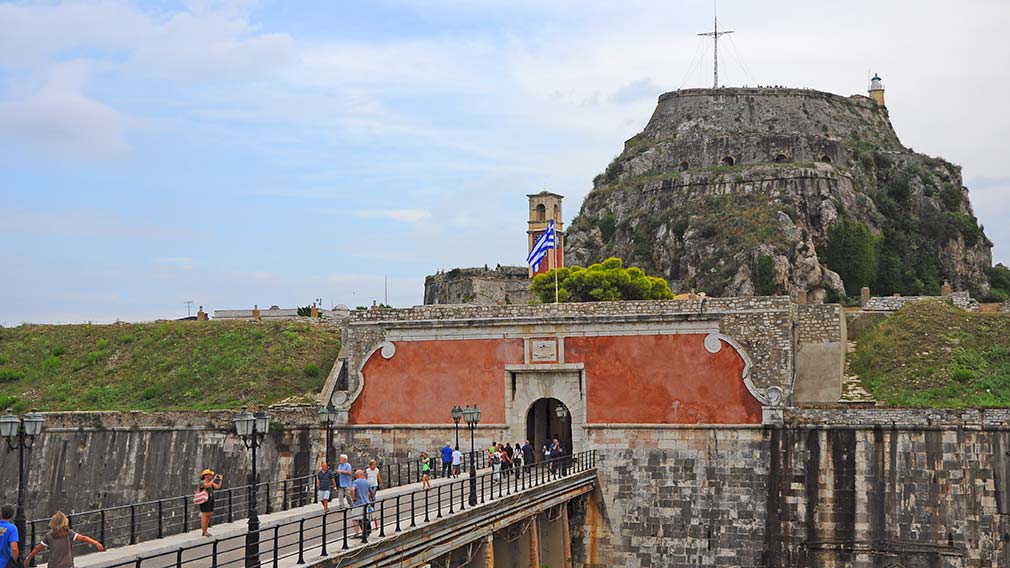
3) New Venetian fortress
This imposing and massive Venetian fortress was built between 1500 and 1600 on the western edge of the old town, but unfortunately it was largely destroyed during the Second World War. Inside there are tunnels and galleries that cannot be visited that connect it to the old fortress and other ancient buildings. Its charm is not comparable to that of the old fortress, but a visit is still worthwhile, because from its top you can enjoy a unique view of the city. Following a recent renovation, the building has become a venue for exhibitions, concerts and cultural activities of international appeal.
4) Spianada
The Spianada is a huge garden square that separates the old Venetian fortress from the rest of the historical centre of Corfu. With a length of one kilometre and a maximum width of over 200 metres, it is the second largest square in Europe. Numerous historical palaces overlook its perimeter, among which the one of San Michele and San Giorgio and the famous "Liston" the spectacular portico that rises under the elegant palaces built in French times.
5) Liston
The Liston is one of the most beautiful streets in the entire historic centre of Corfu. It is a long portico that stands at the base of a series of elegant adjacent buildings. Its construction dates back to French times and given its enormous resemblance to Rue de Rivoli in Paris it is often regarded as "a corner of Paris on Corfu". Under the portico there are restaurants and bars with an ancient and elegant flavour.
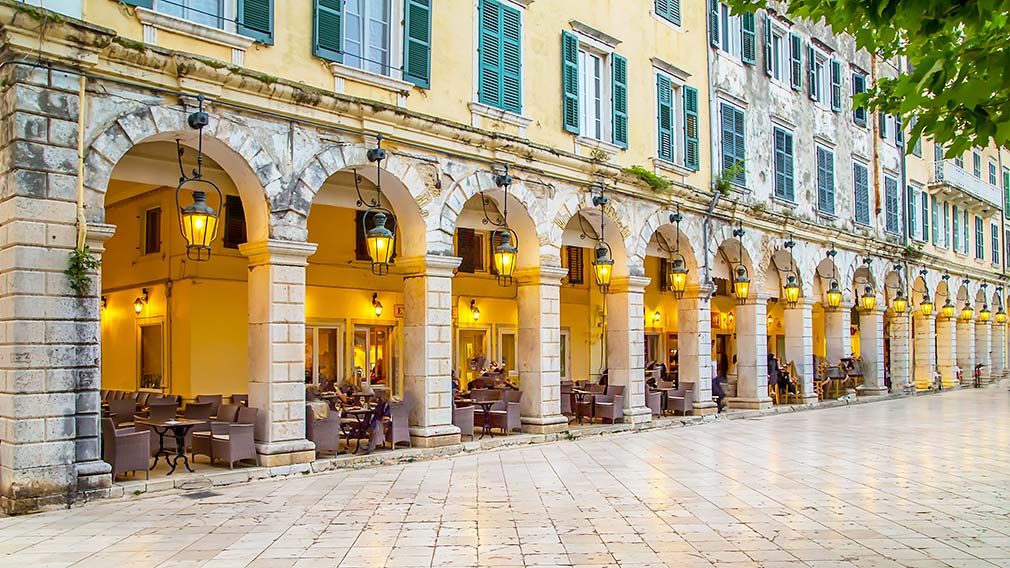
6) Saint Spyridon Church
This Orthodox church is one of the island's landmarks and is located in Corfu town in the heart of the historic centre with its tall bell tower. It was built starting from 1580 to contain the relics of the homonymous Saint still present inside the crypt. The interior has interesting decorations depicting the life of the Saint.
7) Museum of Asian art
This interesting museum is located inside the splendid Palazzo di San Michele e San Giorgio, one of the most beautiful and fascinating in the historic centre of Corfu. The opening of the museum dates back to 1927, when a local diplomat donated a vast collection of objects from Asia to the local authorities. In the following years the exhibition was gradually enriched.
The museum houses masks, weapons and armour of Japanese Samurai, statues, vases and jewellery from China and numerous other artefacts from the East.
8) Municipal art gallery
Inside the Palazzo di San Michele e San Giorgio is located this interesting resident exhibition which offers a prestigious collection of paintings by local and Greek artists from the 16th century to the present day. In addition to the permanent exhibition, numerous temporary exhibitions and cultural events are organized.
9) Dionysios Solomos Museum
Small museum dedicated to the famous Greek poet Dionysios Solomos, mainly known for writing the National Anthem. The museum is located in the historical centre of Corfu town, in the building where the poet lived most of his life. The museum exhibits furniture, manuscripts, photographs, a library containing many interesting volumes.
10) Serbian Museum of Corfu
The Serbian Museum of Corfu tells the story of the 150,000 Serbian soldiers who were exiled after the attack of 6 October 1915 by the Austro-Hungarian army during the First World War. The soldiers were hosted on the island for 3 years by the French occupiers.
The exhibition offers photographs, uniforms, flags, maps and battle plans, weapons and ammunition. The museum serves as a memorial and is supported by the Ministry of Culture and Information of the Republic of Serbia.
11) Vido Island
A small island with a diameter of 1 square kilometre which is located 1 km from the coast, just opposite the town of Corfu. It can be easily reached by small boats that depart frequently from the port of the capital. Before visiting it we recommend a stop at the Serbian museum of Corfu which tells its history. In fact, the island is mainly known because it was the place where the sick and dying Serbian soldiers exiled during the First World War were cured, but given the high mortality rate many were buried at sea. It is no coincidence that the waters around the island are also known as "the tomb of the blue sea". In the 30's the Serbs as a sign of gratitude to the Greeks erected a monument on the island of Vido that can still be visited today.
12) The banknote Museum of the Ionian Bank
The Alpha Bank banknote museum houses an interesting exhibition of some 2000 Greek banknotes printed from 1822 until the introduction of the Euro as well as various printing plates and a copy of the first treasury voucher issued. The museum is housed in an elegant building that originally housed the Ionian Bank, later merged with the Alpha Bank.
13) British Cemetery
The English Cemetery of Corfu, was created in 1814, when the island was under the British protectorate. Over the years it has been the burial place of British officials and diplomats, soldiers and residents. When the British abandoned the island, the cemetery was used for the burial of foreign families living on Corfu. The cemetery has about 500 tombs, many of them monumental, set in a tranquil naturalistic setting.
14) The theater of San Giacomo
The Noble Theatre of St. James is the first modern theatre built in Greece. Its construction began in 1663, but only in 1720 was it destined for theatrical use and soon became the national centre of Greek opera for over a century and a half. It stands in the historical centre in front of the splendid setting offered by the square in front of it.
15) Vlacherna Monastery and Pontikonissi Island
Vlacherna Monastery stands on the small islet of Pontikonissi (meaning mouse island) which is connected to the southern part of the Kanoni peninsula by a narrow concrete footbridge. It is one of the symbolic attractions of the island of Corfu which is generally immortalised by tourists from the top of the promontory above.
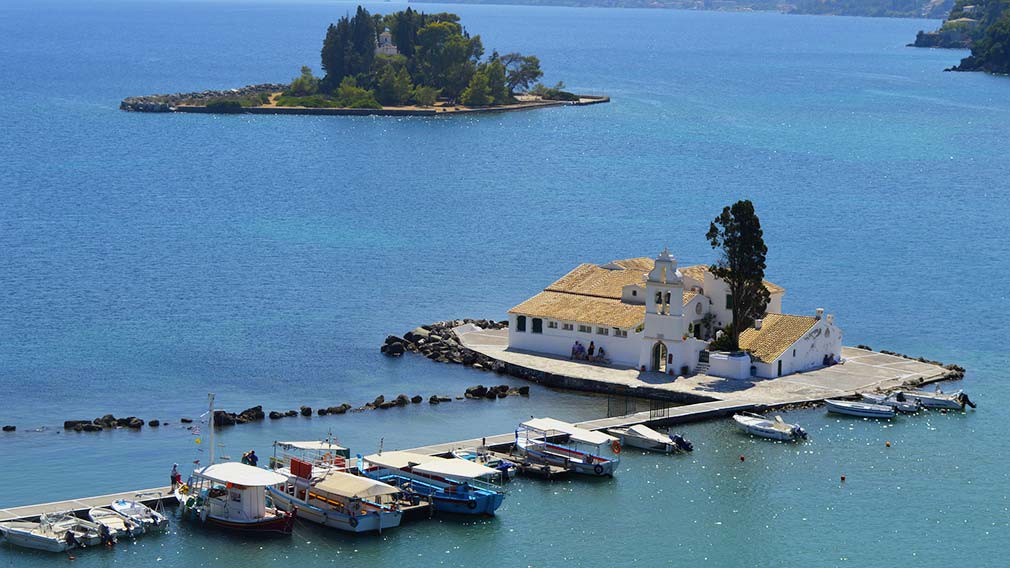
16) Mon Repos Villa
A few steps from the beach of the same name stands this pretty neoclassical villa built in 1828 by the United States High Commissioner of the Ionian Islands Frederick Adam. In 1863 Empress Sissi stayed there and fell so in love with Corfu that she built her summer residence there, the Achilleion Palace, whose architectural style not surprisingly recalls Villa Mon Repos. Since 2001 the villa has opened its doors to the public and is home to an archaeological museum.
17) Paleopolis, the ancient Corfù
4 km south of the capital, on the Kanoni peninsula, lies Paleopolis, the archaeological site of the ancient city of Corfu founded in the 8th century BC by the Doric Greeks of Corinth. The ancient city was an important commercial hub touched by numerous boats that docked in the port originally located between the two Venetian fortresses. Access to the archaeological area is free and with a short walk you can see the ancient walls, the remains of a temple and other buildings.
18) Achilleion Palace
The Achilleion Palace is a neoclassical style building commissioned as a summer residence by Empress Elisabeth of Austria, better known under the pseudonym Sissi. After the premature death of the princess, the palace was purchased by the German Emperor William II of Germany.
The palace was abandoned and fell into a state of decay during the First and Second World War. Only in modern times, after years of restoration work, has the palace been restored to its former glory and opened to the public.
The Achilleion Palace is located on a hill 10 km south of the capital and is easily accessible by both private and public transport. It is appreciated for the beauty of its interior, but also for its well-kept gardens.
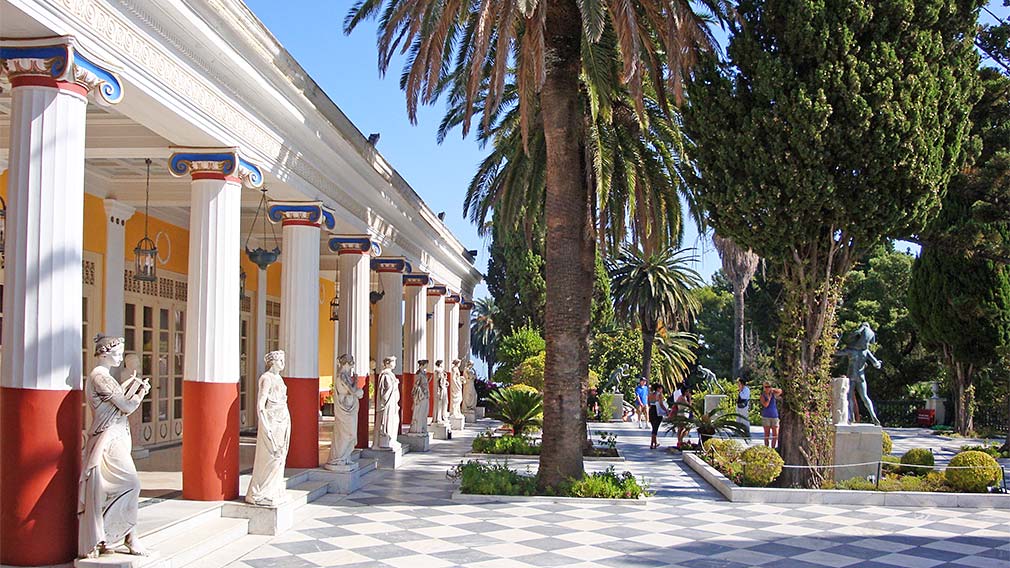
19) Angelokastro Fortress
The ruins of the ancient fortress of Angelokastro bear witness to the Byzantine era of Corfu. This imposing fortress is located on a steep hill overlooking the sea at a height of 300 metres. Angelokastro can be easily reached by your own means of transport, but to access the castle you need to take a long, steep flight of steps. The effort is then rewarded by an incredible view of the Ionian Sea.
20) Paleokastritsa Monastery
This monastery, accessible via a small road from the bay of Agios Spyridon, is located on the top of a small promontory overlooking the sea. Its foundation dates back to 1228, but most of the buildings currently present date back to the 18th century. Thanks to its location it enjoys a breathtaking view of the sea. Walking inside you can enjoy a typical Greek atmosphere with a quiet atmosphere, gardens with flowers and aromatic herbs and a small museum with sacred Orthodox icons. There is also a shop where you can buy typical products, oil as well as the traditional local liqueur "kumquat".

21) Palies old Sinies
This old abandoned village lies a short distance from the summit of Mount Pantokrator. It was built in the 17th century, in an inaccessible but extremely panoramic position, as a defence against pirate raids. In the 60's it was definitely abandoned and its inhabitants moved to the nearby Kassiopi. Today the ruins of the houses and a couple of churches with interesting decorations remain. This destination is mainly reached by trekking lovers. As an alternative it is possible to take part in organized excursions on site.
22) Kassiopi Castle
The ruins of the castle of Kassiopi dominate the bay of the same name from above. The history of the fortress is very troubled as it was destroyed several times and then rebuilt under various dominations. The present appearance is mainly due to the Venetians who rebuilt it in the 15th century.
To reach it you can park in the centre of the village. The access is free and you can take a nice walk along the whole ring of walls that measures more than 1 kilometre.
23) Acharavi Folklore Museum
A permanent exhibition of folkloric objects inaugurated in 2008 and covering an area of over 1000 square metres. The museum has a rich exhibition of photographic material, books, documents, local costumes, agricultural equipment, a traditional oil mill, and other domestic and religious environments dating back to 1800. The collection is personally curated by the owner.
24) Venetian Arsenal
8 km north of the capital, in the tourist resort of Gouvia, there are the ruins of the ancient Venetian arsenal. The site is in a state of abandonment, but the external structure of the building is still intact and with a little imagination it is possible to reconstruct what was an important Venetian building site until 1798.
25) Kapodistrias Museum
This museum is located in Evropouli, inside "Koukouritsa", the family country house of the first head of state of independent Greece Ioannis Kapodistrias. The exhibition displays personal objects, books, maps, works of art, furniture and household appliances that belonged to the great Greek diplomat.
Ancona: the ancient gateway to the East
A trip to the capital city of the Marche region
If you have to leave by ferry from the port of Ancona, do not miss the chance to visit this beautiful city overlooking the Adriatic Sea. Below we give you some useful hints and suggestions about the many attractions in the area
Ancona with its over 100,000 inhabitants is the capital city of the Marche region and is an important Italian port, the most important in the Adriatic Sea in terms of passengers transported. It rises in a characteristic position on an elbow-shaped promontory projected towards the sea. Precisely from its particular geographical shape derives the name of the city chosen by the Greek founders "Ankon" which in ancient Greek means elbow. When you reach Ancona coming from the north, it is impossible not to be enchanted by the beauty of its historical centre dominated by the Cathedral which elegantly overlooks the sea.
Over 2400 years of history
Ancona has behind it centuries and centuries of history and domination closely linked to the sea and the geographical importance of its natural port which has always been a strategic point for the trade with the East.
It was founded by the Greek Dorians of Syracuse in the 4th century B.C. who chose it for its position and for the control of the naval routes towards the northern Adriatic Sea. It was precisely from its founders that Ancona took the name of "Doric city", a name still used today to define the inhabitants of Ancona, often called "Dorici".
In the first century B.C. it became a colony and an important port of the Roman Empire, which promoted the expansion of the sea port under Emperor Trajan. In the following centuries it was first a Maritime Republic, then a city of the Papal State, then a Republic of the Italian Napoleonic Kingdom and finally in 1860 it entered the Kingdom of Italy.
In the historical centre of Ancona you can find numerous historical testimonies of its past.
What to see in Ancona: the ancient part of the city
If you're waiting to embark on the ferry to Greece, a walk from the port to the city will take you to all the main monuments and attractions within easy reach.
Starting on foot from the area near the maritime station and the characteristic Rione degli Archi you will find the Mole Vanvitelliana and the imposing arch of Porta Pia, historical gateway to the city. Continuing along the long port you will find the Church of S. Agostino and the Church del Sacramento which overlooks the sea and the square in front of the Teatro delle Muse with its beautiful façade. From here you can continue on to the seafront visiting the splendid Palazzo della Loggia dei Mercanti and the Church of Santa Maria della Piazza and continuing straight on towards the ancient port dominated by the Triumphal Arch of Traiano and the Arch of Clementino. The walk inside the port can continue for about one kilometre until you reach the red lantern, the entrance door for all naval traffic. From the old port area you can walk or take a lift up the Guasco hill, the historical centre of Ancona dominated by the Cathedral of San Ciriaco with an incredible view of the Gulf of Ancona. Going down from the hill you will find the Roman Amphitheatre (with a short diversion you can visit the Cardeto park with wonderful views of the sea), the Palazzo del Senato, the Church of SS. Pellegrino and Teresa, Palazzo Ferretti, seat of the National Archaeological Museum of the Marches, the imposing Palazzo degli Anziani, the Church of the Santissimo Nome di Gesù and then stop for a coffee on the beautiful Piazza San Francesco overlooking the beautiful Church of San Francesco alle Scale. Continuing on you will find yourself on the real city lounge: Piazza del Plebiscito called Piazza del Papa by the inhabitants due to the presence of the statue of Pope Clement XII. If you have time you can get lost in the many alleys and lanes that make up the urban fabric of the historic centre, you will be surprised by elegant buildings and numerous testimonies of the past difficult to list in a single article.
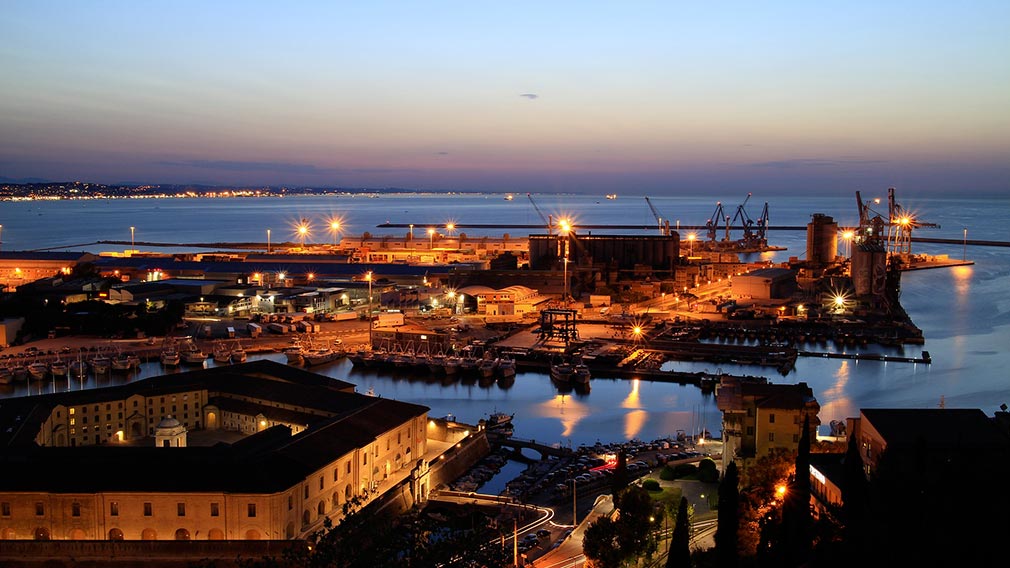
The modern part
From Piazza del Papa you can finish your walk or you can decide to go on to the most modern (but no less beautiful) part of the city cutting the historical centre from sea to sea crossing first Corso Giuseppe Garibaldi and then Viale della Vittoria. Ancona rises on a sort of peninsula and is the only place in Italy where you can see the sun rising and setting over the sea. Halfway along you will find the elegant Piazza Cavour, followed by the Town Hall and the Post Office building. After one kilometre you will arrive in one of the most beautiful areas of the whole city: the Passetto with its Monument ai Caduti which culminates in the staircase leading to an urban beach famous above all for the access to the Passetto Caves, a real peculiarity of Ancona.
Shopping in Ancona
The favourite shopping area for people from Ancona is located in the centre between Corso Garibaldi and Corso Mazzini, where you will find a large number of shops for all tastes and needs.
Shopping centre lovers will find many superstores of the most famous brands in the southern suburbs of the city, also known as Baraccola which is just a few minutes drive from the centre.
Events, entertainment and nightlife
Ancona is a medium-sized city that lacks nothing: there are several cinemas, theatres and museums in the historic centre and on the outskirts.
The nightlife takes shape especially in the central Piazza del Plebiscito and in the narrow streets of the city centre which are full of all kinds of clubs from pubs to disco bars.
Among the most important events organized are the famous Fair of San Ciriaco (patron saint of the city) which welcomes visitors from all over the Marche region, the Festival Del Mare, where the Madonna del Mare, particularly dear to fishermen, is celebrated with a procession of boats in the port.
The surroundings
If you have one or more days at your disposal you can be inspired by the beautiful surroundings of Ancona, all of which can be reached by car or public transport. Among the most evocative places we surely remember the Riviera del Conero with its dream landscapes like the bay of Portonovo or the beaches of the picturesque villages of Sirolo and Numana; the Basilica di Loreto, pilgrimage destination from all over the world, Recanati, the birthplace of the poet Giacomo Leopardi, the Frasassi Caves and other cities of art like Senigallia, Osimo, Jesi.

Eating and drinking
The cuisine of Ancona takes up many of the typical characteristics of the gastronomy of the Marche region, but adds a number of peculiar ingredients, especially related to seafood and fishing. Below we propose you some of them.
Among the most famous seafood dishes you can try the stockfish all'anconetana fine dish that needs a long cooking, the moscioli of portonovo, the D.O.P. mussels fished in the homonymous bay and cooked in a variety of ways by themselves or as a condiment for pasta, the bombetti in porchetta (the condiment in porchetta is made with oil, tomato, garlic and wild fennel) and the crocette in porchetta.
Among the first courses we remind you the traditional vincisgrassi, a variant rich in ingredients of the most famous lasagne, spaghetti with mussels, pasta alla pescatora, ciavattoni allo scoglio (particularly large rigatoni served with tomato and seafood).
Among the second courses we recommend the famous brodetto all'anconetana, a fish soup with local seafood, sardoncini scottadito, cuttlefish with peas, grilled and fried fresh fish from the Adriatic. We recommend you also try the paccasassi, also known as sea fennel, are small green shrubs that grow among the rocks near the sea and are harvested and put in oil.
Finally, among the desserts, the ciambellone is very popular, whether empty or filled with cream or chocolate or sultanas, the maritozzi and the ciambelle di mosto.
The wine of Ancona par excellence is undoubtedly the Rosso Conero, a full-bodied wine produced in the whole area of the homonymous mountain and composed of a mix of Montepulciano and Sangiovese grapes. There are many wineries immersed in the vineyards that are waiting for you for guided tours and tastings. In the immediate surroundings of Ancona are produced other famous red wines such as Lacrima di Morro D'Alba and Rosso Piceno, and white wines such as Verdicchio dei Castelli di Jesi and Verdicchio di Matelica.










